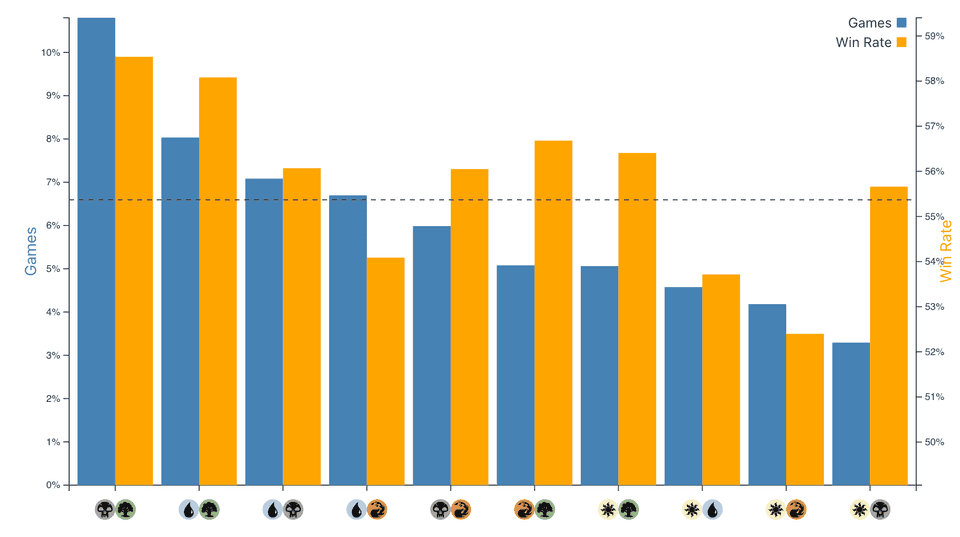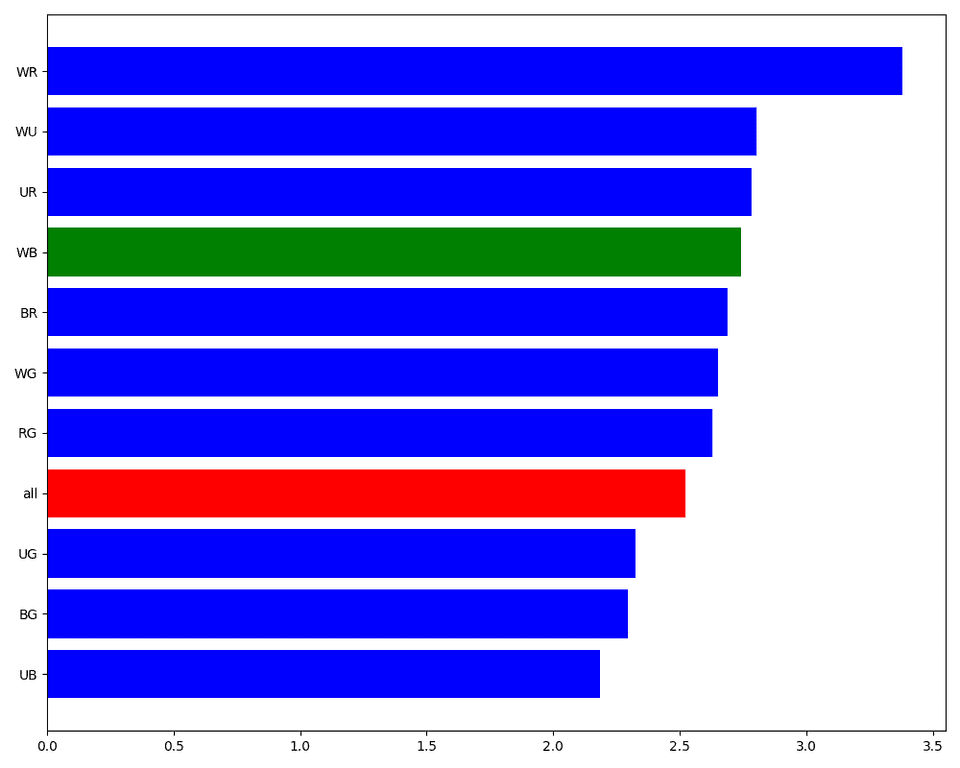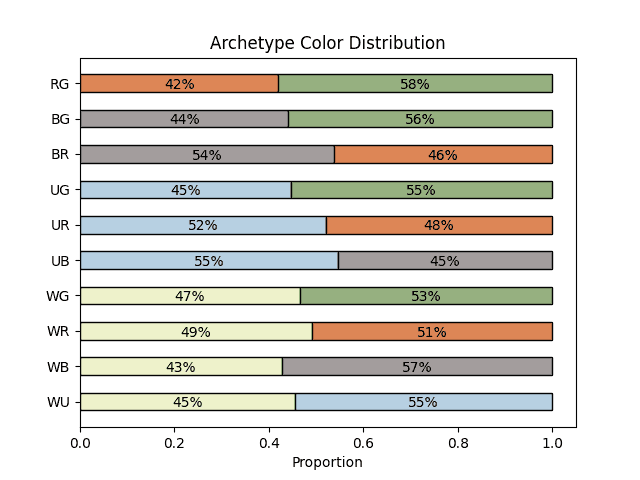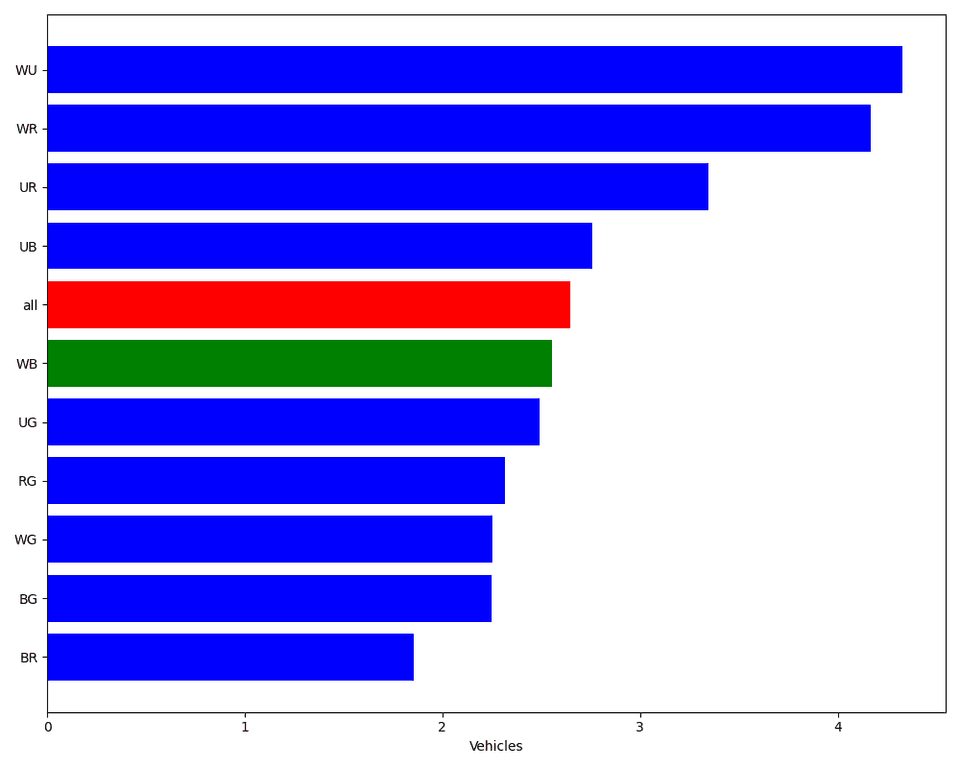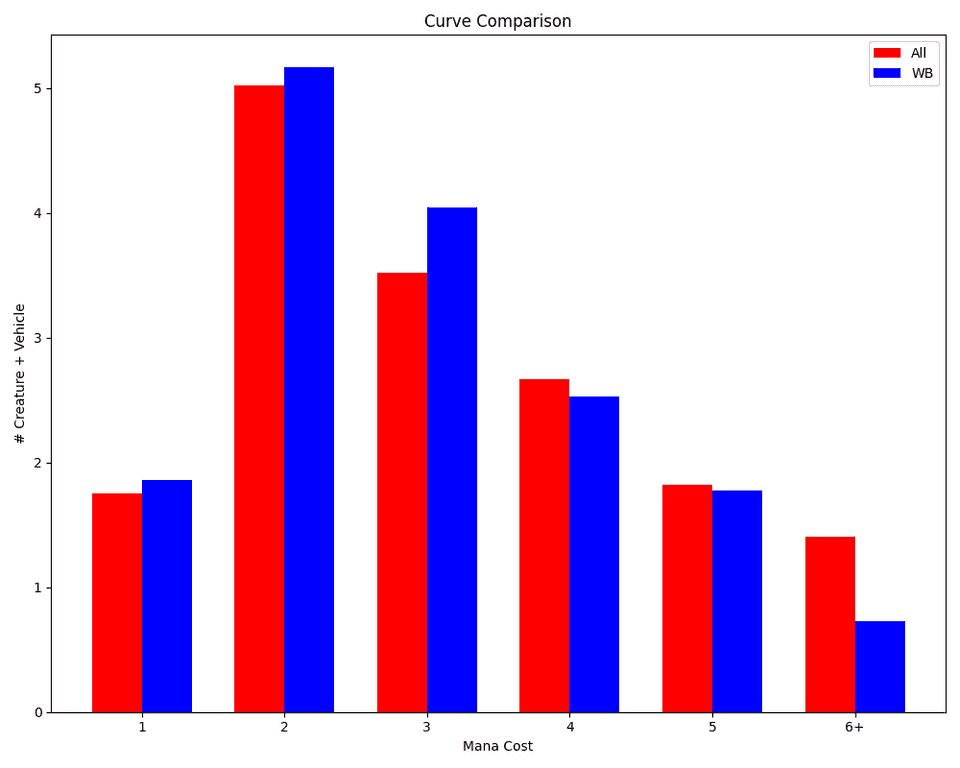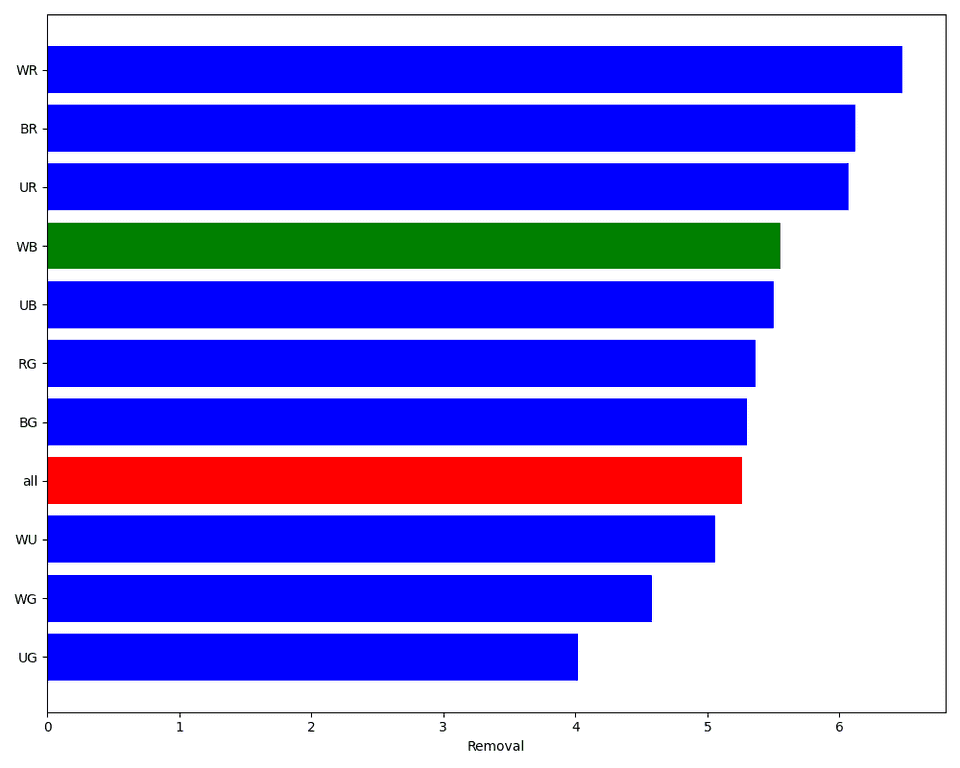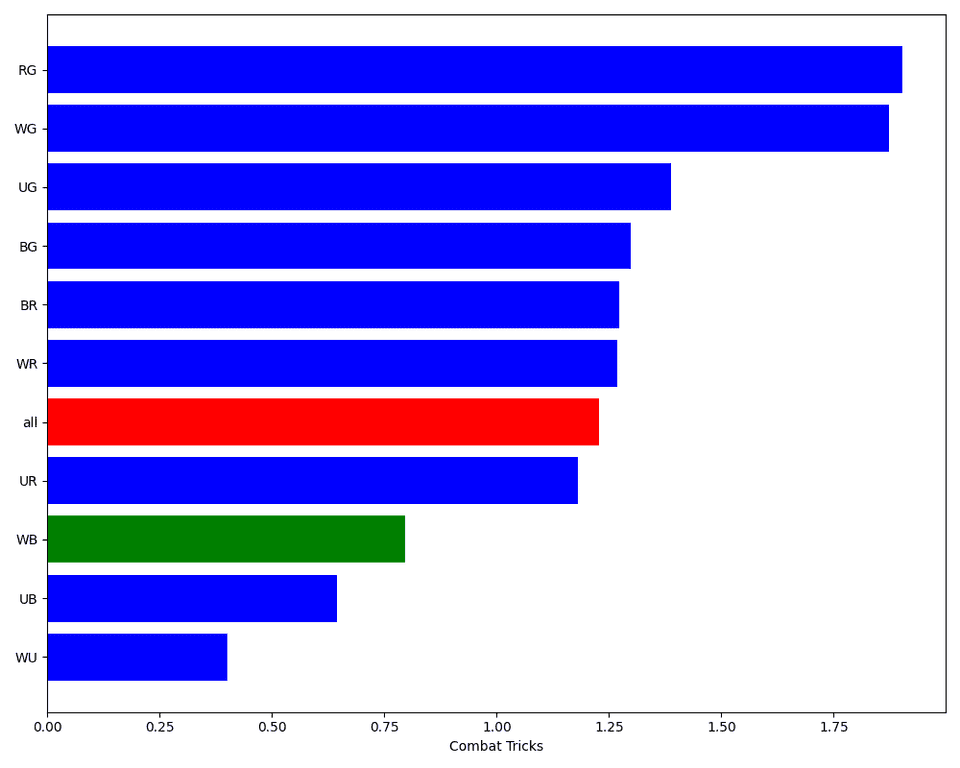Orzhov in Aetherdrift
The early data for Aetherdrift is collected, and we are starting to get a quantitative view of the emerging metagame. White is clearly underperforming compared to the other colors, both in terms of popularity and win rate, while Green is taking the lead.
As more people learn about the format by checking the data on 17Lands or simply getting the reps online, Green is likely to become more contested. As competition for top archetypes increases, less popular ones will eventually have their time to shine. The green decks will have fewer of the premium cards and the unpopular colors will be more open rewarding drafters who can identify the open lane. This showcases the beauty of self-correction in draft formats.
Today we are taking an in-depth look at an underdrafted archetype: White/Black.
Orzhov is currently the least drafted two-colored deck yet maintains a slightly above-average win rate. As more players avoid White, paying attention to an open white lane and knowing which key cards to prioritize could give you an edge. This article explores the results of analyzing trophy decks from 17Lands to uncover what makes the archetype work.
Time will tell if Orzhov has the potential to compete in Aetherdrift, but if it does, make sure you’re ready to capitalize.
Data
Since public datasets for Aetherdrift aren’t available yet, this analysis is based on trophy decks from Platinum to Mythic ranks in Best-of-1 drafts.
This restriction ensures that the decks analyzed are strong examples of the archetype’s optimal strategy. In higher ranks it is more difficult to achieve a trophy, making it more likely that the drafted deck is indeed good and not just lucky.
However, keep in mind that this restriction results in a relatively small sample size. While this dataset provides useful insights, remember that the smaller sample size introduces a margin of error, so interpret the statistics cautiously.
Prince or Pauper: Rarity Breakdown
Draft sets are often categorized into Prince or Pauper formats. The difference between those two is the importance of higher rarity compared to lower rarity cards. If games revolve around powerful rares and mythics, the format is considered a Prince format. Vice versa, gameplay being mostly driven by commons and uncommons is the characteristic of a Pauper format.
Instead of categorizing Aetherdrift as a whole, let’s examine each archetype to see how much they rely on higher rarity cards for success.
Looking at the chart we see that the average deck has 2.5 higher rarity cards. Orzhov is placed around that value, so there is no indication that it depends more on bombs than other decks.
As a side note, White/Red appears to rely heavily on bombs for success. Since Boros is the worst-performing archetype, it’s not surprising to see an above-average number of rares in its trophy decks.
Color Distribution
The distribution of the two colors in the archetype is often not symmetrical. One color, most often the overall stronger one, becomes dominant, while the second one fulfills a support role.
The following chart shows the distribution of colored pips in each archetype. Green is the dominant color across its archetypes, whereas White plays more of a supporting role.
White/Black specifically has a heavily skewed distribution with 57% of pips being black. This suggests that drafting Orzhov purely for White is likely suboptimal. Orzhov can act as a pivot when you’re committed to Black but find your other color heavily contested.
Creature Count and Curve
White/Black trophy decks play on average 13.6 creatures and 2.5 vehicles. The amount of vehicles is close to the overall average.
Since vehicles require creatures to attack and block, they can’t directly replace creatures in the curve. As a result, it’s easy to make the mistake of including too many vehicles in a deck. Sticking to 2-3 is a good rule of thumb that you often hear from content creators and is confirmed here by the data.
Looking at the mana curve we see that Orzhov has a small emphasis on lower curve creatures while playing significantly less 6+ drops. Overall, the curve closely matches the format’s average, suggesting that Orzhov aims for a balanced, midrange playstyle.
Next, we’ll examine each spot on the mana curve and identify the best cards to fill each slot. The following tables are displaying the average number of copies played in White/Black trophy decks, as well as the game in hand win rate and ALSA value to get a holistic view of which cards are desirable.
1-Drops
Orzhov decks play 1.86 1-drops on average, but not all of them are worth playing. Engine Rat is by far the best one, with a ridiculously high win rate of 60%. This small deathtouch creature is an excellent answer to the dominant Green decks, making Orzhov its ideal home.
| Name | Rarity | Avg. # in decks | Game in Hand WR | ALSA |
|---|---|---|---|---|
| Engine Rat | common | 0.83 | 60.0% | 5.42 |
| Voyager Glidecar | rare | 0.11 | 59.9% | 2.4 |
| Nesting Bot | uncommon | 0.47 | 58.8% | 4.31 |
| Basri, Tomorrow's Champion | rare | 0.11 | 57.8% | 2.37 |
| Gas Guzzler | rare | 0.14 | 56.8% | 2.63 |
| Brightfield Glider | common | 0.17 | 52.8% | 7.09 |
2-Drops
When it comes to 2-drops you want to play around 5-6 creatures (5.17 on average). There is one card that sticks out both in win rate and how often it is played in trophy decks - Wreckage Wickerfolk. This creature smooths your draws, and can bring you to max speed by flying over the opponents defences. It is the only common with a positive win rate. The only better 2-drop is Gloryheath Lynx, but with an ALSA of 2.4 and being an uncommon, you won’t get too many of those.
Leonin Surveyor is the second most played 2-drop, but performs much worse than the Wickerfolk. Again this could be attributed to the prevalence of the green decks, negating a 2/2 first strike creature easily. Most other common and uncommon 2-drops underperform and should be avoided when possible.
| Name | Rarity | Avg. # in decks | Game in Hand WR | ALSA |
|---|---|---|---|---|
| Gloryheath Lynx | uncommon | 0.4 | 62.2% | 2.9 |
| Wreckage Wickerfolk | common | 1.19 | 59.9% | 4.65 |
| Zahur, Glory's Past | rare | 0.31 | 59.6% | 3.21 |
| Skyseer's Chariot | rare | 0.1 | 59.2% | 3.07 |
| Bulwark Ox | rare | 0.12 | 56.7% | 2.08 |
| Sundial, Dawn Tyrant | uncommon | 0.27 | 56.6% | 4.09 |
| Spotcycle Scouter | common | 0.12 | 55.9% | 7.15 |
| Wretched Doll | uncommon | 0.21 | 55.5% | 4.25 |
| Dune Drifter | uncommon | 0.52 | 55.1% | 5.16 |
| Leonin Surveyor | common | 0.75 | 54.5% | 5.59 |
| Deathless Pilot | common | 0.46 | 53.6% | 5.95 |
| Canyon Vaulter | uncommon | 0.2 | 53.1% | 3.81 |
| Walking Sarcophagus | common | 0.31 | 53.0% | 6.94 |
| Bloodghast | rare | 0.06 | 48.2% | 3.68 |
| Interface Ace | common | 0.09 | 47.8% | 6.57 |
3-Drops
Going further and looking at the 3-drops we see the single most important card in this archetype, the signpost uncommon Embalmed Ascendant. Out of the average 4.04 three mana creatures the trophy decks fill 1.27 of those spots with this card. With a win rate of 62.6% it is the best creature for this archetype, outclassing all rares and mythics.
Another card that sticks out is Carrion Cruiser, a vehicle that lets you return a creature from the graveyard to your hand. Recurring Embalmed Ascendant while gaining a 3/2 vehicle that can be easily crewed by your small creatures is a powerful value play for this archetype.
Lotusguard Disciple is a trap — its ability to enable single creature attacks isn't impactful enough, and lifelink is less valuable in this slower format.
| Name | Rarity | Avg. # in decks | Game in Hand WR | ALSA |
|---|---|---|---|---|
| Embalmed Ascendant | uncommon | 1.27 | 62.6% | 4.79 |
| Carrion Cruiser | uncommon | 0.25 | 57.7% | 3.77 |
| Gastal Raider | uncommon | 0.27 | 56.6% | 3.98 |
| Grim Javelineer | common | 0.44 | 56.4% | 6.86 |
| Mutant Surveyor | common | 0.6 | 55.9% | 6.28 |
| Camera Launcher | common | 0.07 | 54.2% | 6.89 |
| Kalakscion, Hunger Tyrant | uncommon | 0.04 | 54.2% | 6.19 |
| Lotusguard Disciple | common | 0.36 | 54.1% | 6.25 |
| Air Response Unit | uncommon | 0.11 | 54.0% | 5.13 |
| Daring Mechanic | common | 0.08 | 52.2% | 6.72 |
| Voyager Quickwelder | common | 0.28 | 51.7% | 6.07 |
| Aetherjacket | common | 0.09 | 50.9% | 6.36 |
| Cloudspire Captain | uncommon | 0.07 | 46.9% | 3.66 |
4-Drops
Moving on we discover the last key component to White/Black in Aetherdrift: Pactdoll Terror. With 1.07 copies on average it is by far the most played 4-drop, of which trophy decks play 2.53. It’s a grindy card, that enables max speed without attacking, while providing a good defensive body and bolstering up the life total.
Swiftwing Assailant is another common with positive win rate to shout out as it provides a way to win the game once the ground is gummed up with Engine Rats and Zombie tokens.
| Name | Rarity | Avg. # in decks | Game in Hand WR | ALSA |
|---|---|---|---|---|
| Gonti, Night Minister | rare | 0.17 | 59.9% | 1.8 |
| Pactdoll Terror | common | 1.07 | 59.0% | 4.48 |
| Swiftwing Assailant | common | 0.38 | 57.0% | 6.98 |
| Pride of the Road | uncommon | 0.27 | 55.9% | 4.32 |
| Guidelight Synergist | uncommon | 0.25 | 55.2% | 4.55 |
| Wreck Remover | common | 0.09 | 55.0% | 7.75 |
| Cryptcaller Chariot | rare | 0.03 | 54.9% | 2.42 |
| Wickerfolk Indomitable | uncommon | 0.04 | 54.4% | 5.77 |
| Ripclaw Wrangler | common | 0.14 | 54.3% | 7.18 |
| Brightfield Mustang | common | 0.09 | 50.6% | 6.94 |
5-Drops
As for 5-drops there are two good option at common. Both Broadcast Rambler and Streaking Oilgorger work fine here and go relatively late in the draft. The magic number seems to be around two card at this spot on the curve, with trophy decks playing on average 1.78.
Risen Necroregent looks like it's exactly what the deck wants to do, but has a lower than expected win rate. That's not to say that the card is not good, but just to keep in mind when evaluating the pack during the draft.
| Name | Rarity | Avg. # in decks | Game in Hand WR | ALSA |
|---|---|---|---|---|
| The Speed Demon | mythic | 0.07 | 60.6% | 1.62 |
| Guardian Sunmare | rare | 0.13 | 57.9% | 1.87 |
| Broadcast Rambler | common | 0.54 | 57.7% | 6.35 |
| Streaking Oilgorger | common | 0.51 | 57.3% | 6.68 |
| Risen Necroregent | uncommon | 0.31 | 55.3% | 3.49 |
| Unswerving Sloth | uncommon | 0.11 | 53.7% | 4.48 |
6+ Drops
The most common curve topper at 6+ mana is Detention Chariot, providing immediate value by removing an opposing creature or artifact. On average, we see 0.73 cards at this cost, and based on the win rates for the common and uncommon options it does not seem to be too important.
| Name | Rarity | Avg. # in decks | Game in Hand WR | ALSA |
|---|---|---|---|---|
| Demonic Junker | rare | 0.12 | 61.4% | 1.92 |
| Detention Chariot | uncommon | 0.29 | 56.3% | 3.48 |
| Valor's Flagship | mythic | 0.05 | 56.0% | 1.74 |
| Shefet Archfiend | uncommon | 0.13 | 53.6% | 5.07 |
| Chitin Gravestalker | common | 0.14 | 51.5% | 6.16 |
So now that we took a look at how to best fill 16.18 creature/vehicles slots in our winning Orzhov decks let’s round it out with some removal and noncreature spells.
Removal
Ways to interact with what the opponent is doing is very important in this format, which is why the averag deck plays 5.26 removal spells in their deck.
White/Black is positioned right there with 5.5 removal spells. Let’s have a look which ones you should prioritize.
On top of the list is Perilous Snare, an absolute bomb and best card in these colors in general. Not only is it an excellent way of removing an opposing non-land permanent, but its max speed ability gives you inevitability in most board stall situations.
Besides the rares, the most efficient removal spells are Gallant Strike at uncommon and Spin Out at common, which deal with problematic big green creatures easily. Ride's End is also an excellent option that has the benefit of exiling the creature, which is relevant in this environment.
Grim Bauble is also worth mentioning as both a removal spell for the early game as well as a mana sink later on. It's also a neat way to trigger your Pactdoll Terror.
The remaining uncommon and common options are noticably worse than the ones mentioned just now, but it’s still vital to get the removal count up to 5-6.
| Name | Rarity | Avg. # in decks | Game in Hand WR | ALSA |
|---|---|---|---|---|
| Perilous Snare | rare | 0.25 | 68.3% | 1.63 |
| Demonic Junker | rare | 0.12 | 61.4% | 1.92 |
| Gallant Strike | uncommon | 0.36 | 59.7% | 3.72 |
| Spectacular Pileup | rare | 0.15 | 59.3% | 2.27 |
| Spin Out | common | 0.88 | 59.2% | 3.08 |
| Ride's End | common | 0.79 | 58.8% | 4.02 |
| Grim Bauble | common | 0.81 | 57.8% | 3.97 |
| Quag Feast | rare | 0.12 | 56.5% | 2.32 |
| Detention Chariot | uncommon | 0.29 | 56.3% | 3.48 |
| Momentum Breaker | uncommon | 0.28 | 56.2% | 3.61 |
| Collision Course | common | 0.61 | 55.9% | 5.28 |
| Hellish Sideswipe | uncommon | 0.17 | 55.8% | 4.35 |
| Syphon Fuel | common | 0.3 | 54.9% | 6.02 |
| Scrap Compactor | common | 0.11 | 54.1% | 6.42 |
| Shefet Archfiend | uncommon | 0.13 | 53.6% | 5.07 |
| Locust Spray | uncommon | 0.08 | 52.0% | 5.86 |
| Aetherjacket | common | 0.09 | 50.9% | 6.36 |
Combat Tricks
Combat tricks don’t feel like an important part of this format, but it’s still good to now what’s going on and for which to look out for.
Most tricks are played in green and White/Black with an average of 0.8 per deck is below the overall average of 1.18. The most commonly played card in this category is Maximum Overdrive and has a slightly above average win rate. Don't forget that this trick grants deathtouch, so it can be a way to deal with otherwise difficult to handle green creatures.
| Name | Rarity | Avg. # in decks | Game in Hand WR | ALSA |
|---|---|---|---|---|
| Basri, Tomorrow's Champion | rare | 0.11 | 57.8% | 2.37 |
| Maximum Overdrive | common | 0.51 | 56.6% | 6.3 |
| Lightshield Parry | common | 0.1 | 52.9% | 7.71 |
| Locust Spray | uncommon | 0.08 | 52.0% | 5.86 |
Non-creature Spells
After accounting for everything we saw so far and assuming we’re playing 17 lands, this leaves us with approximately 0.5 cards in the remaining category.
Here we see that Risky Shortcut is the most played card in the list. It does have a slighlty lower win rate than what we would hope to see, but as a 23rd card it should be fine. It has some nice applications, like surprising the opponent with max speed before combat.
Cursecloth Wrappings is an abosulte bomb that you should not sleep on and once it's out on the battlefield you'll notice that a lot of creatures are already Zombies and are getting buffed.
| Name | Rarity | Avg. # in decks | Game in Hand WR | ALSA |
|---|---|---|---|---|
| Cursecloth Wrappings | rare | 0.2 | 61.1% | 2.3 |
| Back on Track | uncommon | 0.15 | 57.3% | 4.28 |
| Intimidation Tactics | uncommon | 0.22 | 56.6% | 5.39 |
| Hour of Victory | uncommon | 0.32 | 56.3% | 4.61 |
| Risky Shortcut | common | 0.38 | 55.5% | 6.93 |
| Roadside Assistance | uncommon | 0.07 | 53.8% | 5.34 |
| Tune Up | uncommon | 0.07 | 52.3% | 5.88 |
| Lightwheel Enhancements | common | 0.08 | 52.2% | 7.67 |
Lands
Finally let’s have a look at the mana base and see if we can get an edge with some non-basic lands. Some numbers about the average trophy deck, they play 16.72 lands, 7.43 Plains and 7.81 Swamps.
As you can see both Raceway Lands have good stats and are easy includes. Surprisingly Scoured Barrens has a pretty low win rate, which suggests that you want to play on curve and start at turn one.
The two Roads lands are best to be avoided, the potential pilot is not worth a tap land, most of the time.
| Name | Rarity | Avg. # in decks | Game in Hand WR | ALSA |
|---|---|---|---|---|
| Amonkhet Raceway | uncommon | 0.05 | 59.1% | 6.95 |
| Avishkar Raceway | common | 0.19 | 57.5% | 7.49 |
| Bleachbone Verge | rare | 0.17 | 55.6% | 4 |
| Night Market | common | 0.27 | 54.8% | 4.85 |
| Scoured Barrens | common | 0.53 | 53.8% | 6.68 |
| Foul Roads | uncommon | 0.14 | 52.4% | 7.3 |
| Country Roads | uncommon | 0.1 | 51.0% | 7.14 |
Takeaways
This overview tried to give you a holistic view under the hood of a well-perfoming White/Black deck in Aetherdrift. As we’ve seen at the beginning, White is the weakest color in the meta game so far and is currently underdrafted. Being able to leverage this situation and knowing how to construct a good Orzhov deck can be very useful when everyone fights over the green cards. That being said though, it for sure is not a tier 1 archetype and you shouldn’t try to force it.
The key cards for the archetype are Engine Rat (60%), Wreckage Wickerfolk (59.9%), Embalmed Ascendant (62.6%) and Pactdoll Terror (59%). Keep your eyes open for them late in the pack to assess if it is safe to move into the archetype. If you don’t see these cards late someone else is probably drafting them and then you should look for another lane
If you found this useful and would like to stay in the loop for future content, you can subscribe to the State of the Format newsletter.
